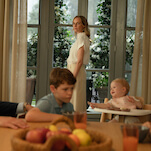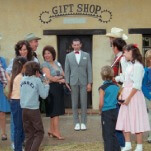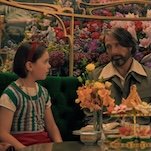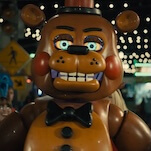The highs and lows of Pride And Prejudice on the screen

It is a truth universally acknowledged that every few years the public must be in want of another version of Pride And Prejudice. Since it was first published in 1811, Jane Austen’s novels have never been out of print. Deemed worthy of scholarly study in the 1940s, Austen’s work now threads a fine line between popular and academic appeal; one is just as likely to enjoy her books for fun as to dissect them in a classroom. By far, her most popular and influential novel is 1813’s Pride And Prejudice. The love story of lively Elizabeth “Lizzy” Bennet and haughty Fitzwilliam Darcy—the most satisfying of all Austen romances—continues to capture imaginations more than 200 years after the novel was published. That’s thanks in no small part to an ever-growing list of adaptations and reimaginings that have brought the story to life over and over again.
But why do we keep revisiting this world in particular? Pride And Prejudice is the rare literary classic that offers a genuine happy ending yet balances its crowd-pleasing romance and comedy with intelligence and seriousness. It effortlessly subverts the notion that great books must be tragic ones. At times laugh-out-loud funny, Austen plays the neat trick of keeping her prose as polite and mannered as the society in which her characters live. Her acrobatic wordplay hides humor behind sarcasm, irony, and understatement, and her characters still feel real and recognizable two centuries after Austen wrote them.
The latest in a long line of Pride And Prejudice miniseries, movies, books, spin-offs, and modern-day retellings is Death Comes To Pemberley. Based on a 2011 book by 94-year-old mystery writer P.D. James, the BBC miniseries hops across the pond to PBS on October 26. The adaptation maintains Pride And Prejudice’s period setting but flashes forward to six years after the events of the original novel. Darcy’s massive country estate, Pemberley, serves as the main locale and adds a decidedly Downton Abbey-esque flare to the proceedings.
In place of Austen’s twinkling wit and satire, the series offers a murder mystery, a melodramatic love triangle, and a bit of upstairs-downstairs intrigue. Thanks to the time shift, the series is able to deepen some of the original novel’s secondary characters by revisiting them in different circumstances. Lizzy’s boorish little sister Lydia (Jenna Coleman); Lydia’s caddish husband, George Wickham (Matthew Goode); and Mr. Darcy himself (Matthew Rhys) particularly benefit from the additional nuance. Introduced at the height of marital bliss, Death Comes To Pemberley gives Lizzy (Anna Maxwell Martin) and Darcy some interesting relationship drama that doesn’t feel like a retread. And even though some of the characterization feels a bit off—Lizzy has lost some of her original spark—and the central mystery lacks complexity, it’s pleasant enough to spend more time in Austen’s familiar world.
Like all of Austen’s novels, Pride And Prejudice centers on the social and marital woes of the British landed gentry. Due to a law of entail that sees property passed through male heirs, the five daughters of the Bennet household are set to inherit nothing upon their father’s death. Their histrionic mother, Mrs. Bennet, sees marriage as the ultimate aim for her daughters. Without a good match (in wealth, if not in happiness), her daughters will be destitute. Lizzy, the second oldest but most intelligent Bennet, is determined to marry for love as well as for financial stability. Slighted at a ball by the proud—and at times socially awkward—Mr. Darcy, Lizzy is all too quick to write him off as a wealthy snob and believe the worst of him at every turn (the prejudice to Darcy’s pride). It’s only when Darcy and Lizzy both make an effort to be better for one another that they get their happy ending—all the more satisfying for having been earned and not merely granted.
Two major film adaptations—made 65 years apart—have brought Austen’s Pride And Prejudice to the big screen. In 1940 Greer Garson and Laurence Olivier slipped into the iconic central roles. The film makes several significant changes to the story, not least of which is swapping the novel’s Regency-era setting for a Victorian one. Empire waists are replaced with hoop skirts and crinoline, which filmmakers thought would look better on-screen. In general there’s an enjoyable comic exuberance to the film that matches its updated setting (think the opening scene in Gone With The Wind) more so than the novel’s neoclassical one.
In 2005, director Joe Wright cast Keira Knightley and Matthew Macfadyen as the stars of his Pride And Prejudice. The film downplays the satire (although not the comedy) and takes a more romantic approach—both by emphasizing the love stories and in the literary sense of the word. In Wright’s Romantic aesthetic, the natural world reflects his characters’ emotional states. Darcy’s failed first proposal takes place outside in a torrential downpour, while the lovers’ reconciliation happens as the sun peaks over the horizon of a misty field. That climax even styles Darcy as a Heathcliff-esque hero with a flowing coat and proudly displayed chest hair. Where the 1940 version offers broad comedy and satire, Wright goes for sentiment. Both work well as individual films, and it’s a testament to Austen that her novel is rich enough to provide fodder for these wildly divergent interpretations.
Those who prefer a truly faithful rendering of Austen’s novel must turn to the much beloved 1995 A&E/BBC collaboration starring Jennifer Ehle and Colin Firth. BBC made four previous miniseries adaptations of Pride And Prejudice, but this version remains the gold standard. Where the 1940 and 2005 films tipped their hands one way or the other, this adaptation perfectly balances the novel’s satire and romance. Clocking in at more than five hours, writer Andrew Davies fits in almost every major plot point, retains good chunks of Austen’s dialogue, and places more emphasis on Mr. Darcy. And what a Darcy he is. When asking, “Why do we keep adapting Pride And Prejudice?” it’s tempting to simply answer: Colin Firth. The actor perfectly captures the way Darcy’s haughty pride melts into warmer affection under Lizzy’s influence. Alongside “Prince Charming” and “bad boy with a heart of gold,” Firth’s performance helped solidify “Mr. Darcy” as a popular romantic archetype.








































